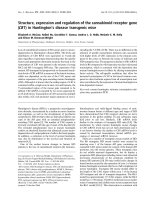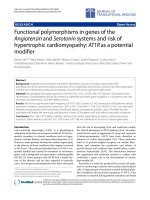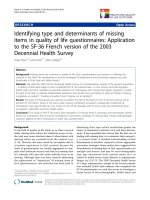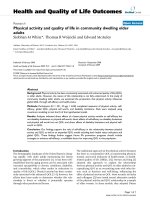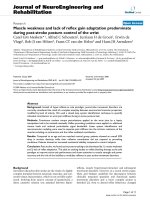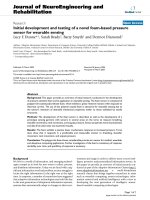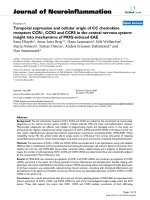báo cáo hóa học: " Recombinant expression and purification of the 2,5-diketocamphane 1,2-monooxygenase from the camphor metabolizing Pseudomonas putida strain NCIMB 10007" potx
Bạn đang xem bản rút gọn của tài liệu. Xem và tải ngay bản đầy đủ của tài liệu tại đây (659.9 KB, 8 trang )
ORIGINAL Open Access
Recombinant expression and purification of the
2,5-diketocamphane 1,2-monooxygenase from
the camphor metabolizing Pseudomonas putida
strain NCIMB 10007
Maria Kadow, Stefan Saß, Marlen Schmidt and Uwe T Bornscheuer
*
Abstract
Three different Baeyer-Villiger monooxygenases (BVMOs) were reported to be involved in the camphor metabolism
by Pseudomonas putida NCIMB 10007. During (+)-camphor degradation, 2,5-diketocamphane is formed serving as
substrate for the 2,5-diketocamphane 1,2-monooxygenase. This enzyme is encoded on the CAM plasmid and
depends on the cofactors FMN and NADH and hence belongs to the group of type II BVMOs. We have cloned and
recombinantly expressed the oxygenating subunit of the 2,5-diketocamphane 1,2-monooxygenase (2,5-DKCMO) in
E. coli followed by His-tag-based affinity purification. A range of compounds representing different BVMO substrate
classes were then investigated, but only bicyclic ketones were converted by 2,5-DKCMO used as crude cell extract
or after purification. Interestingly, also (-)-camphor was oxidized, but conversion was about 3-fold lower compared
to (+)-camphor. Moreover, activity of purified 2,5-DKCMO was observed in the absence of an NADH-
dehydrogenase subunit.
Keywords: Baeyer-Villiger monooxygenases, camphor, Pseudomonas putida NCIMB 10007, 2,5-diketocamphane 1,2-
monooxygenase, bicyclic ketones
Introduction
The discovery of the e nzymatic Baeyer-Villiger reaction
is closely connected to the exploration of the biodegra-
dation of camphor (1) in Pseudomonads (Figure 1).
Initial studies on the microbial decomposition of (+)-1
by Pseudomonas putida NCIMB 10007 isolated from
sewage sludge were already carried out in 1959
(Bradshaw et al. 1959) and the involved enzymes were
separated and characterized during the following decade.
In studies of the enzymatic lactonization of the inter-
mediate 2,5-diketocamphane (3) from the (+)-camphor-
grown organism it was shown that two enzyme fractions
were responsible for the Baeyer-Villi ger-monooxygena se
(BVMO) catalyzed reaction step ( Conrad et al. 1961,).
The first enzyme turned out to be a FMN-coupled
NADH-dehydrogenase [EC 1.6.8.1], while the second
subunit was claimed to be a ketolactonase. Since
mechanistic similarities to the chemical Baeyer-Villiger
oxidation of bicyclic ketones (Meinwald and Frauenglass
1960) were detected, the nomenclature of the ketolacto-
nase was changed to a BVMO. In 1965 a second lacto-
nizing system for the degradation of (-)-1 was found
(Conradetal.1965a).Thusitwasclaimedthat(+)-1
and its derivatives were onl y converted by the
(+)-camphor induced 2,5-diketocamphane 1,2-monooxy-
genase (2,5-DKCMO), while (-)-1 is converted by the
(-)-camphor induced 3,6-diketocamphane 1,6-monooxy-
genase (Jones et al. 1993) (Figure 1). Later it was
claimed, that whichever enantiomer of camphor is given
to the growth medium, both diketocamphane monooxy-
genases are ind uced (Gagnon et al. 1994). The ability to
decompose camphor turned out to be inducible in
several fluorescent Pseudomonads, where most of the
involved enzymes, including both type II monooxy-
genases, are located on a 230 kb (165 MDa) plasmid
(CAM plasmid, Figure 2) (Chakrabarty 1976).
* Correspondence:
Department of Biotechnology and Enzyme Catalysis, Institute of
Biochemistry, Greifswald University, Felix-Hausdorff-Str. 4, D-17487 Greifswald,
Germany
Kadow et al. AMB Express 2011, 1:13
/>© 2011 Kadow et al; licensee Springer. This is an Open Access article distributed under the terms of the Creative Commons Attribution
License ( g/licenses/by/2.0), which permits unrestricted use, distribution , and reproduction in any medium,
provide d the original work is properly cited.
During the 1990s, several st udies on the conversion of
cyclic and bicyclic alkanones using whole Pseudomonas
putida cells or partially purified enzymes of this
organism were performed. Regarding the evolutionary
predisposition of the three BVMOs involved in camphor
metabolism, diketocamphane monoo xygenases turned
out to catalyze the efficient production of optically
active bicyclic lactones in an enantiodivergent and
highly selective ma nner (Gagnon et al. 1994,). Especially
bicyclo [3.2.0.] ketones and norcamphor-derived com-
pounds were investigated and benzyloxylactone,
achieved from a norcamphor derivative, emerged as an
important precursor for the insect antifeedant azadirach-
tin (Ga gnon et al. 1994,; Gagnon et al. 1995b). A series
of monocyclic ketones were further explored and
2-alkylcyclopentanones and 3-substituted cyclobuta-
nones were converted with often complementary enan-
tioselectivity in comparison to transformations with
whole cells of Acinetobacter calcoaceticus,whichwas
finally attributed to 2-oxo-Δ3-4,5,5 -trimethylcylopen te-
nylacetic acid monooxygenase (Gagnon et al. 1995a,;
Gro gan et al. 1993). These studies were performed with
cells or cell-free extracts, which contained all three
BVMOs or at least both diketocamphane monooxy-
genases. Even though separation of the distinct activities
was tried by purification, the presence of impurities
could not be excluded. Therefore, reproducible and
reliable methods for separation and purification are
required for the accurate characterization of these
enzymes.
The availability of efficient cofactor recycling strategies
for NADH-regeneration in BVMO-ca talyzed oxidatio ns,
e.g. by the formate dehydrog enase from Candida boidi-
nii, were also exploited. Moreover, coupling processes of
horse liver alcohol dehydrogenase together with
2,5-DKCMOwereusedtoproduceopticallyactivelac-
tones starting from alcohol precursors (Gagnon et al.
1994,; Gagnon et al. 1995b).
Several new BVMOs were investigated recently and
while most of them refer to type I, which are FAD and
NADPH-dependent, (Fraaije et al. 2005,; Re hdorf et al.
2007,; Völker et al. 2008,; Rehdorf et al. 2009) only a
few examples for FMN/NADH-containing type II
BVMOs were investigated up to now. A reason might
be the challenging overexpress ion of these enzymes in a
heterologous host, since in contrast to type I BVMOs
the oxygenating and dehydrogenase subunits are distinct
proteins.
So far all characterization and biocatalytic experiments
with 2,5-diketocamphane 1,2-monooxygenase were per-
formed using large scale cultivations of the wild type
strain P. putida NCIMB 10007 with subsequent multiple
purification and separation steps of the involved
enzymes. We report here the first recombinant
Figure 1 Camphor degradation in Pseudomonas putida NCIMB 10007: In the first step camphor (1) is hydroxylated by the P450
Cam
-
monooxygenase (Unger et al. 1986,) followed by an oxidation by the 5-exo-alkohol dehydrogenase (Koga et al. 1989) yielding the corresponding
diketocamphane (3). (+)-1 is degraded by the 2,5-dicetocamphane 1,2-monooxygenase (a), while (-)-1 requires the 3,6-diketocamphane 1,6-
monooxygenase (b). Both resulting lactones are unstable and lead to spontaneous formation of the 2-oxo-Δ3-4,5,5-trimethylcylopentenylacetic
acid, which is further converted to a coenzyme A derivative (4), which is again a substrate for a third involved BVMO (2-oxo-Δ3-4,5,5-
trimethylcylopentenylacetic acid monooxygenase, often designated as MO2) (Ougham et al. 1983).
Figure 2 Operon of the CAM-plasmid: CamA: putidaredoxin reductase (M12546.1); CamB: putidaredoxin (J05406.1); CamC: cytochrome
P-450cam (M12546.1); CamD: 5-exo-alkohol-dehydrogenase (M13471.1); CamP: 1,2-diketocamphane 2,5-monooxygenase (AY450285.1); CamQ:
lactone hydrolase (AY450285); CamR: regulatory protein. The putative 3-ketoacid-CoA-transferases A and B were identified in this work by gene-
walking PCR.
Kadow et al. AMB Express 2011, 1:13
/>Page 2 of 8
overexpression of the oxygenating 2,5-diketocamphane
1,2-monooxygenase from P. putida NCIMB 10007 in
Escherichia coli followed by simplified purification via
affinity chromatography and characterization of the
enzyme.
Material and methods
Enzymes, chemicals and media
Pfu
+
-polymerase was obtained from Roboclon (Berlin,
Germany) and dNTPs from Roth (Karlsruhe, Germany).
Restriction enzymes were obtained from New England
Biolabs (Beverly, MA, USA). For SDS-PAGE analysis,
the prestained PAGE ruler plus from Fermentas (St.
Leon-Rot, Germany) was used. All other chemicals were
purchased from Fluka (Buchs, Switzerland), Sigma-
Aldrich (Munich, Germany) or Acros Organics (Geel,
Belgium). For DNA-purification from PCR, the MinE-
lute PCR-purification Kit by Qiagen (Hilden, Germany)
was used. Furthermore the Miniprep Kit from Qiagen
was used for plasmid purification. HisTrap 5 mL FF col-
umns and Sephadex G25 were obtained by GE Health-
care (Uppsala, Sweden). The plasmid pET-28b(+) was
from Novagen (Darmstadt, Germany). The BCA kit was
purchased from Interchim (Montluçon, France).
Amplification and cloning
Amplification of the 2,5-DKCMO gene was performed
with chromosom al DNA containing the CAM-plasmid
with oligonucleo tides supplemented with restriction sites
for NdeI at the N-terminus and XhoI at the C-terminus
(NdeI_2,5-DKCMO_fw: 5’ - GGAATTCATATGAAA
TGCGGATTTTTCCATACCCC-3’ ;2,5-DKCMO_X-
hoI_rv: 5’- CCGCTCGAGTCAGCCCATTCGAACCTT-
3’). After initial denaturation for 5 min at 95°C, the cycling
program was followed for 25 cycles: 45 s, 95°C denatura-
tion, 45 s , 58°C primer annealing, 70 s, 72°C elongation.
The final elon gation step was perfor med over 10 minutes
at 72°C. The resulting 1092 kb fragment was digested with
NdeIandXhoI and ligated into pET-28b digested with the
same enzymes. The resulting plasmid with a N-terminal
His-tag fusion was called pET-28_2,5-DKCMO (Figure 3).
Bacterial strains and culture conditions
P. putida NCIMB 10007 (equivalent to ATCC 17453)
was purchased from the German National Resource
Center for Biological Material (DSMZ). For cultivation
of P. puti da, basal salt medium without antibiotics as
described previously was used (Gagnon et al. 1994).
E. coli cells we re cultivated in terrific broth (TB) med-
ium (12 g tryptone, 24 g yeast, 4 g glycerol in 1 L buffer
autoclaved separately). Overnight cultures were grown
in Luria Bertani (LB) medium (10 g tryptone, 5 yeast,
5gNaClin1LdestH
2
O). LB and TB media were
supplemented with 100 μg/mL kanamycin.
Transformation of E. coli strain BL21-DE3 (Novagen,
genotype: [95 F - ompT hsdSB (rB-mB-) gal dcmrn e131
(DE3)]) with pET-28_2,5-DKCMO was carried out by
the heat shock method described by Chung et al. (1989).
Expression of recombinant 2,5-DKCMO in E. co li BL21
was performed by cultivation at 37°C to an OD
600
of
0.5, than addition IPTG to a final concentration of 0.1
mM and shifting the culture to 20°C and 200 rpm for
another 16 h of cultivation.
Gene expression analysis
Gene expression analysis was performed with crude cell
extract. Samples standardized to cell amount were taken
during cultivation. Cells were harvested by centrifuga-
tion and resuspended in sodium phosphate buffer (50
mM, pH 7.5). Cell disruption was performed by Fas-
tPrep (40 s, 4 m/s; MP Biomedicals, Solon, OH, USA).
For SDS-PAGE analysis, the supernatant was substituted
with Laemmli buffer (Laemmli 1970). SDS-PAGE was
carried out on 12% resol ving gels. Proteins were stained
with a Coomassie R250/G250 solution.
Enzyme purification
Cells were harvested by centrifugation and resuspended
in sodium phosphate buffer (50 mM, pH 7.5). Cell dis-
ruption was performed by a single passage through a
French pressure cell. Recombinant 2,5-DKCMO w as
purified by affinity chromatography via N-terminal His-
tag on an automated Äkta purifier system. After centri-
fugation of disrupted cells for 45 min at (10,000 × g),
the supernatant with recombinant 2,5-DKCMO was
added to the column. A 5 mL HisTrap FF crude column
with bound Ni
2+
was equilibrated with sodium phos-
phate buffer (100 mM, pH 7.5) supplemented with 300
mM NaCl and 30 mM imidazole. After passing through
of the c rude extract, the column was washed with three
column volumes of sodium phosphate buffer (100 mM,
pH 7.5) supplemented with 300 mM NaCl and 30 mM
imidazole followed by two column volumes of sodium
phosphate buffer (100 mM, pH 7.5) supplemented with
300 mM NaCl and 60 mM imidazole to remove unspe-
cific bound proteins. Elution was performed by adding
three column volumes of 300 mM imidazole in sodium
phosphate buffer (100 mM, pH 7.5) supplemented with
300 mM NaCl. Fractions of washing and elution steps
were collected to analyze purity by SDS-PAGE. In order
to remove imidazole and NaCl from the eluate, the
pooled elution fractions were loaded to a 60 mL size
exclusion column (Sephadex G25 matrix), which was
equ ilibrated with sodium phosphate buff er (50 mM, pH
7.5) before. Proteins fractions were recognized via online
absorption measurement at 280 nm and collected.
Determination of protein content of purified and
desalted protein as well as crude extract was carried out
Kadow et al. AMB Express 2011, 1:13
/>Page 3 of 8
with the BCA-kit and a standard curve of BSA in the
same buffer in a range of 2-0.005 mg/mL was used.
Samples were measured in triplicates in three different
dilutions.
Biocatalytic reactions and GC analysis
For biocatalysis, His-tag purified 2,5-DKCMO, crude
extracts of E. coli BL21 pET28_2,5-DKCMO cultivations
and resting cells were used. Reactions were carried out
in sodium phosphate buffer (50 mM, pH 7.5) Substrates
were used in conc entrations from 0.5-2 mM, the cofac-
tor FMN was used at a final concentration of 0.3 mM.
NADH was used in equimolar amounts to the substrate.
Purified 2,5-DKCMO was employed in concentrations
of 1.5-2 mg/mL, crude extracts in concentrations of
12-15 mg/mL. Incubation was performe d in 24-well
MTP at 800-1000 rpm. Sample volume was 1 mL.
Extraction of substrates and products was performed by
vortexing of samples with 600 μland400μlofethyl
acetate subsequently. Samples were dried over anhy-
drous sodium sulfate. Separation of aqueous and organic
phase w as done by centrifugation. The organic s olvent
was evaporated in a vacuum centrifuge. 120 μLoffresh
EtOAc was added, and samples were analyzed by
GC-MS on a QP 2010 (Shimadzu Europa GmbH, Duis-
burg, Germany) with a BPX5 column (5% phenyl-/95%
methylpolysilphenylene siloxane, SGE GmbH, Darm-
stadt, Germany). Injection temperature was set to 220 °
C. Detection temperat ure for (+)-1,(-)-1, 13, 14 and 15
was 60°C for 5 min followed by a gradient of 10°C/min
to 180°C maintained for 3 min. Detection temperature
for 16 was 120°C. For 17, 240°C for 5 min followed by a
gradient of 2°C/min to 270°C was used and maintained
for 5 min. 6-8 were analyzed at 60°C. 9 and 10 were
detected isothermal at 160°C. Detection temperature for
11 was 90°C and for 12 100°C.
Specific activity is given in units per milligram (U/mg)
protein. One unit is def ined as the amount of enzyme
that catalyzes the oxidation of 1 μmol of substrate per
minute.
Results
Cloning, expression and purification of
2, 5-diketocamphane 1,2-monooxygenase
The 2,5-diketocamphane 1,2-monooxygenase (2,5-
DKCMO) from Pseudomonas putida NCIMB 10007
isencodedontheCAMoperononthetransmissible
230kbCAMplasmid(Rheinwaldetal.1973).First
Figure 3 Vector 2,5-DKCMO_pET-28 for express ion of recombinant 2,5-DKCMO from P. putida NCIMB 10007 under control of
T7 promoter in E. coli BL21. The 2,5-DKCMO-gene was introduced using the sites of restriction endonucleases NdeI and XhoI for cloning.
Kadow et al. AMB Express 2011, 1:13
/>Page 4 of 8
chromosomal and plasmid DNA were isolated from the
P. putida strain NCIMB 10007 cultivated with camp hor
as sole carbon source. The gene was then amplified by
gradient PCR using gene specific primers derived from
the corresponding gene [GenBank: AY450285]. The
PCR product was afterwards ligated into the expression
vector pET-28b fused to the N-terminal His-tag to allow
a functional expression of the 2,5-DKCMO in E. coli
and easy protein purification by affinity chromatography.
The N-terminal tag was favored compared to the
C-terminal tag, because our experience with 4-hydrocya-
cetophenonemonooxyge nase (HAPMO) f rom P. putida
JD1 indicated that BVMO-e xpression is de creased by
the use of C-terminal tags (Rehdorf et al. 2009).
The utilization of E. coli BL21(DE3) as expression host
yielded primarily soluble 2,5-DKCMO protein after 16 h
cultivation at 20°C in TB medium, while cultivation at
30°C yielded in insoluble inclusion bodies (data not
shown). SDS-PAGE analysis of crude cell extract led to
a clear band at approx. 40 kD shown in Figure 4, which
corresponds to the theoretical estimated molecular
weight of 42.9 kD of the His-tagged protein.
After successful recombinant expression, a nickel-
based affinity chromatography of the His-tagged protein
and the subsequent removal of imidazole by size exclu-
sion chro matography on a G25 column was performed
and yi elded pure protein (Figure 4, lane 3) with a purifi-
cation factor of six (Table 1). The fractions containing
purified protein were colorless, which confirmed
previous studies, in which FMN is not covalent ly bound
to the enzyme (Trudgill 1986).
Substrate specificity of 2,5-DKCMO
To determine the substrate specificity of 2,5-DKCMO a
variety of compounds representing diffe rent classes of
BVMO-substrates were investigated in biocatalysis
experiments using the crud e enzyme extract (Figure 5).
Only bicyclic ketones were converted under the chosen
conditions by the crude extract containing 2,5-DKCMO
(Table 2). For all monocyclic ketones ( 6-8), aromatic
ketones ( 9-11), the aliphatic 2-decanone (12)testedas
well as for 1-indanone (16) and progesterone (17)no
conversion could be determined. The biocatalysis with
substrates, which were converted was further investi-
gated using the pure enzyme an d specific activities were
determined in bioca talysis experiments in 1 mL scale
with 2 mM of substrates at 25°C for 15 h (Table 2).
Interestingly, in our study (-)-1 was also converted by
the 2,5-DKCMO, although purified enzyme isolated
from wild-type strain cultivation was claimed to be
specific for the (+)-enantiomer (Jones et al. 1993). As we
have r ecombinantly produced the BVMO i n the E. coli
host, which does not have its own BVMO and the con-
version of (-)-camphor was observed with crude cell
extract as well as His-tag purified protein, we can only
speculate whether the purified protein described by
Jones et al. 1993 was indeed homogenous. Norcamphor
(13) and (±)-cis-bicyclo [3.2.0] hept-2-en-6-one (14)
were better accepted as substrates than camphor in
general, and furthermore (R,R)-bicyclo [2.2.1] heptane-
2,5-dion (15), which is structurally similar to the natural
substrate 2,5-diketocamphane (3), is also converted. In
addition, the conversion of 14 was performed with rest-
ing cells expressing 2,5-DKCMO, where 11% conversion
could be observed after 6 h of biocatalysis at 0.5 mM
substrate concentration.
Discussion
The oxygenating subunit of the 2,5-diketocamphane
monooxygenase was successfully cloned and overex-
pressed recombinantly in E. coli as the heterologous
expression host. Hence, this enzyme is now easy
Figure 4 SDS-PAGE analysis of 2,5-DKCMO: lane 1: marker: 150,
130, 100, 70, 55, 35, 25, 15 kDa; lane 2: crude extract (41 μg
total protein); lane 3: purified protein (22 μg).
Kadow et al. AMB Express 2011, 1:13
/>Page 5 of 8
available at stable quality and protein engineering
studies are possible for the first time. The purification
using the N-terminal His-tag via nickel based affinity
chromatography turned out to be efficient and fast.
While in previous purifications of the enzyme from
wild type cultivatio ns, huge cultur e volumes were used,
in this study drastically smaller amounts of heterolo-
gous culture is needed to produce comparable
amounts of pure protein. Conrad et al. used a 10 L
culture and obtained 240 mL crude extract to produce
52 mg of pure protein via a chromatography based
purification protocol with three steps, which corre-
sponds to a recovery o f 15% (Conra d et al. 1965a,). 28
years later Jon es et al. were able to increase the purity
and t he yield up to 19.5%. From a 10 L culture volume
49 mg of pure enzyme were obtained (Jones et al.
1993). In this work 8 mg of pure protein were achieved
out of a 400 mL culture, which highlights the advan-
tages of recombinant expression and the fusion of an
enzyme to a His-tag.
Previous studies on the purified protein determined a
molecularsizeof2,5-DKCMOof78kDabynative
PAGE. Under denaturating conditions two identical
subunits w ith a molecular weight of each 37 kDa were
identified (Trudgill 1986). The estimated mass from the
amino acid sequence of one subunit of 2,5-DKCMO is
40.7 kDa and fused to t he His-tag 42.8 kDa. SDS-PAGE
analysis of E. coli crude extract and pure protein
resulted in protein bands corresponding to approx.
40 kDa, which corresponds to those molecular weights
determined in earlier studies within a c ertain error
range of the SDS-PAGE method.
Fractions containing 2,5-DKCMO collected by affinity
chromatography turned out to be colorless. It was pre-
viously shown that FMN binding occurs non-covalently
(Conrad et al. 1961), and therefore we assume that
FMN is lost during the purification process. To achieve
better stability of the enzyme, FMN was added to the
protein solution immediately.
The requirement of non-heme Fe
2+
ions for oxygenat-
ing activity was intensively discussed in the past as well
(Conradetal.1965a).Fe
2+
was thought to be essentia l
for the genera ti on of the active form of oxygen required
for the BVMO reaction. In fact, there are no mechanistic
requirements for transition metal-ions in the enzyme,
which could al so be confirmed by the availability of
BVMO-activity of pure protein in the absence of Fe
2+
within this study.
Table 1 Purification of 2,5-DKCMO via nickel-based affinity chromatography and imidazole removal
Step V
[mL]
Volumetric activity
a
[U/
mL]
Activity
a
[U]
Protein amount
b
[mg/
mL]
Specific activity [mU/
mg]
Yield
[%]
Factor
Crude extract 30 0.0021 0.063 14 0.15 100 1
Purified and
desalted
7 0.0015 0.0103 1.6 0.90 16 6
a
Activity was determined towards (+)-camphor and analyzed by GC-MS.
Activity of the purified protein containing imidazole prior to the size exclusion chromatography could not be determined, since imidazole interferes with the
used GC-MS column.
b
Protein amount as determined by the BCA a ssay.
Figure 5 Substrates used for 2,5-DKCMO-catalyzed Baeyer-Villiger oxidation. 6-8 represent the monocyclic ketones, 9- 11 substitute
aromatic ketones, 12 served as an example for aliphatic and 13-16 for bicyclic ketones.
Kadow et al. AMB Express 2011, 1:13
/>Page 6 of 8
In this work, recombinant expressio n and purificati on
of 2,5-DKCMO, an oxygenating subunit, led to a “dehy-
drogenase-missing” pure protein and it could be shown
that the enzyme is still able to oxidize bicyclic ketones.
Previously, marginal BVMO-activity was o btained
although no NADH dehydrogenase was detectable in
the final preparation of 2,5-DKCMO, which was final ly
reasoned with impurities or the fact that the oxygen
component is able to operate as its own NADH dehy-
drogenase in presence of FMN and remove electrons
from NADH to catalyze the reaction (Trudgill 1986).
Low activities of purified oxygenating component were
observed earlier as well and were explained by a weak
coupling of the mentioned subunits in vitro (Conrad et
al. 1965b).
We also observed that o xygenating activi ty of 2,
5-DKCMO expressed in E. coli is higher in the crude
extract or whole cell approaches when compared to
pure protein. This fact might be explainable by several
components of E. coli cells that may substitute the miss-
ing NADH dehydrogenase. Coexpression experiments
with a suitable NADH dehydrogenase may further
improve the activity of 2,5-diketocamphane 1,2-monoox-
ygenase considerably and could thus gene rate valuable
catalysts for organic synthesis providing access to indus-
trial valuable precursors for e.g. azadirachtin.
Regarding the requirement for cofactor regeneration
in larger scale applications, the 2,5-DKCMO might also
be used in whole cell approaches with t he expression
system introduced in this report.
Abbreviations
FMN: flavin mononucleotide; NADH: nicotinamide adenine dinucleotide;
BVMO: Baeyer-Villiger monooxygenase; 2,5-DKCMO: 2,5-diketocamphane 1,2-
monooxygenase
Acknowledgements
We are grateful to the Deutsche Bundesstiftung Umwelt (DBU, Osnabrück,
Germany, Grant No. AZ13234) for financial support and Christin Peters and
Ina Menyes for assistance in the laboratory.
Competing interests
The authors declare that they have no competing interests.
Received: 1 June 2011 Accepted: 23 June 2011 Published: 23 June 2011
References
Bradshaw WH, Conrad HE, Corey EJ, Gunsalus IC (1959) Microbiological
degradation of (+)-camphor. J Am Chem Soc 4492:5507–5507
Chakrabarty AM (1976) Plasmids in Pseudomonas. Ann Rev Genet 10:7–30
Chung CT, Niemela SL, Miller RH (1989) One step preparation of competent
Escherichia coli - Transformation and storage of bacterial cells in same
solution. Proc Natl Acad Sci USA 86:2172–2175
Conrad HE, DuBus R, Namvedt M, Gunsalus IC (1965a) Mixed function oxidations
II: separation and propertiers of the enzymes catalyzing camphor
lactonization. J Biol Chem 240:495–503
Conrad HE, Lieb K, Gunsalus IC (1965b) Mixed function oxidation III: An electron
transport complex in camphor ketolactonization. J Biol Chem 240:4029–4037
Conrad IE, Dubus R, Gunsalus IC, York N (1961) An enzyme system for cyclic
ketone lactonization. Biochem Bioph Res Co 6:293–297
Fraaije MW, Wu J, Heuts DPHM, van Hellemond EW, Spelberg JHL, Janssen DB
(2005) Discovery of a thermostable Baeyer-Villiger monooxygenase by
genome mining. Appl Microbiol Biot 66:393–400. doi:10.1007/s00253-004-
1749-5.
Gagnon R, Grogan G, Groussain E, Pedragosa-Moreau S, Richardson PF,
Roberts SM, Willetts AJ, Alphand V, Lebreton J, Furstoss R (1995a) Oxidation
of some prochiral 3-substituted cyclobutanones using monooxygenase
enzymes: A single-step method for the synthesis of optically enriched 3-
substituted γ-lactones. J Chem Soc Perkin Trans 1:2527–2528
Gagnon R, Grogan G, Levitt MS, Peter MR, Willetts AJ (1994) Biological Baeyer-
Villiger oxidation of some monocyclic and bicyclic ketones using
monooxygenases from Acinetobacter calcoaceticus NCIMB 9871 and
Pseudomonas putida NCIMB 10007. J Chem Soc Perkin Trans 1:2537–2543
Gagnon R, Grogan G, Roberts SM, Villa R, Willetts AJ (1995b) Enzymatic Baeyer-
Villiger oxidations of some bicyclo[2.2.1]heptan-2-ones using
monooxygenases from Pseudomonas putida NCIMB 10007: Enantioselective
preparation of a precursor of Azadirachtin. J Chem Soc Perkin Trans
1:1505–1505. doi:10.1039/p19950001505.
Grogan G, Roberts SM, Wan PWH, Willetts AJ (1993) Camphor grown
Pseudomonas putida, a multifunctional biocatalyst for undertaking Baeyer-
Villiger monooxygenase-dependent biotransformations. Biotechnol Lett
15:913–918
Jones KH, Smith RT, Trudgill PW (1993) Diketocamphane enantiomer-specific
‘Baeyer-Villiger’ monooxygenases from camphor-grown Pseudomonas putida
ATCC 17453. J Gen Microbiol 139:797–805
Koga H, Yamaguchi E, Matsunaga K, Aramaki H, Horiuchi T (1989) Cloning and
nucleotide sequences of NADH-putidaredoxin reductase gene (camA) and
putidaredoxin gene (camB) involved in cytochrome P-450cam hydroxylase of
Pseudomonas putida. J Biochem 106:831–836
Laemmli UK (1970) Cleavage of structural proteins during the assembly of the
head of bacteriophage T4. Nature 227:680–685
Meinwald J, Frauenglass (1960) The Baeyer-Villiger oxidation of bicyclic ketones.
J Am Chem Soc 82:5235–5239. doi:10.1007/bf01086344.
Ougham HJ, Taylor DG, Trudgill PW (1983) Camphor revisited: Involvement of a
unique monooxygenase in metabolism of 2-oxo-Δ
3
-4,5,5-
trimethylcyclopentenylacetic acid by Pseudomonas putida. J Bacteriol
153:140–152
Rehdorf J, Kirschner A, Bornscheuer UT (2007) Cloning, expression and
characterization of a Baeyer-Villiger monooxygenase from Pseudomonas
putida KT2440. Biotechnol Lett 29:1393–1398. doi:10.1007/s10529-007-9401-y.
Rehdorf J, Zimmer CL, Bornscheuer UT (2009) Cloning, expression,
characterization, and biocatalytic investigation of the
Table 2 conversion of several bicyclic ketones by crude cell extract and specific activities for pure 2,5-DKCMO
Substrate Conversion
a
[%] Specific activity
b
[mU/mg]
(+)-Camphor ((+)-1) 66 0.9
(-)-Camphor ((-)-1) 25 0.3
Norcamphor (13) 98 1.3
(±)-cis-bicyclo [3.2.0] hept-2-en-6-one (14) 100 1.4
(R,R)-bicyclo [2.2.1] heptane-2,5-dion (15) 94 0.06
a
Conversion was determined by GC-MS analysis of biocatalysis samples with crude extract from E. coli cells overexpressing DKCMO at a substrate concentration
of 1 mM after 23 h.
b
Specific activity was calculated from conversion of substrate by pure enzyme determined by GC-MS at different points of time.
Kadow et al. AMB Express 2011, 1:13
/>Page 7 of 8
4-hydroxyacetophenone monooxygenase from Pseudomonas putida JD1.
Appl Environ Microb 75:3106–3114. doi:10.1128/aem.02707-08.
Rheinwald JG, Chakrabarty AM, Gunsalus IC (1973) A transmissible plasmid
controlling camphor oxidation in Pseudomonas putida. Proc Natl Acad Sci
USA 70:885–889
Trudgill PW (1986) Camphor revisited: Studies of 2,5-diketocamphane 1,2-
monooxygenase from Pseudomonas putida ATCC 17453. J Bacteriol
165:489–497
Unger BP, Gunsalus RP, S SG (1986) Nucleotide sequence of the P. putida
cytochrome P-450cam gene and its expression in Escherichia coli. J Biol
Chem 261:1158–1163
Völker A, Kirschner A, Bornscheuer UT, Altenbuchner J (2008) Functional
expression, purification, and characterization of the recombinant Baeyer-
Villiger monooxygenase MekA from Pseudomonas veronii MEK700. Appl
Microbiol Biot 77:1251–1260. doi:10.1007/s00253-007-1264-6.
doi:10.1186/2191-0855-1-13
Cite this article as: Kadow et al.: Recombinant expression and
purification of the 2,5-diketocamphane 1,2-monooxygenase from the
camphor metabolizing Pseudomonas putida strain NCIMB 10007. AMB
Express 2011 1:13.
Submit your manuscript to a
journal and benefi t from:
7 Convenient online submission
7 Rigorous peer review
7 Immediate publication on acceptance
7 Open access: articles freely available online
7 High visibility within the fi eld
7 Retaining the copyright to your article
Submit your next manuscript at 7 springeropen.com
Kadow et al. AMB Express 2011, 1:13
/>Page 8 of 8
